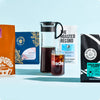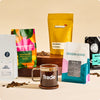Did you get some fantastic new coffee gear as a gift this holiday season? Someone must really love you! Now that your home barista setup is all kitted out, you may be looking for some advice to get brewing even better than before. You’ve come to the right place: Not only do we know a thing or two about the best fresh-roasted coffee in the world, we also have some ideas about the tools you need to maximize that quality. You can also take our coffee quiz to see what we recommend based on the coffee tools you have.
Here are some tips and tricks to get you started with your cool new caffeinated toys.
Grinders
Before you jump right in to making delicious coffee, you’ll want to do two main things: Season your grinder and calibrate it.
Seasoning your grinder is kind of like seasoning your cast-iron pan: You want to make sure you put a little bit of use on the burrs before using them to grind top-quality coffee, just like you want to make sure your pan has a nice thin coating of oil to create a nonstick surface before your first batch of over-easy eggs.
All it takes is running some coffee beans through the grinder, enough to “break them in.” It’s best to use old or stale coffee for this, since you’ll want to throw it away rather than brew it; you can also buy a small amount of inexpensive coffee from the bulk-beans section of your local grocery store, or ask your favorite barista if there are any off-retail beans at the café that they wouldn’t mind selling you at a discount.
Home grinders like Fellow’s Ode are designed to move through smaller amounts of coffee at a time than commercial-grade ones, so you don’t need to season with a ton of coffee beans. We recommend grinding about 100 grams (about 3.6 ounces) of coffee beans as a start.
One way to make your grinder-seasoning coffee do double duty is taking this opportunity to calibrate or dial-in the grinder at the same time.
As you’re seasoning your grinder, change the grind setting: Start by grinding your seasoning beans on the coarsest setting, and while the coffee is moving through the grinder, adjust it finer incrementally. If you’re normally a pour over drinker, you’ll want to find the setting at which the grind is medium-fine, with a texture somewhere between sea salt and table salt. Occasionally take out some of the ground coffee and inspect it: Look at it closely in your palm or spread out on a white piece of paper to see it in detail and rub some of it between your fingers to feel the texture.
Finding the just-right grind will require some trial-and-error during brewing, but this is a great way to start on your way to understanding your grinder and setting it up for success.
Brewers
There are countless ways to make coffee, and each one of them comes with a seemingly innumerable list of advice and opinions. Trying to find a technique to follow can feel like falling down the rabbit hole — and who has that kind of time?
Before you get too dizzy, just remember that coffee only has two ingredients (coffee grounds, water), and the most complicated instructions aren’t always the best ones to follow — especially if they sap all the joy and excitement out of getting a brand new brewing device for the holidays.
The secret to a great coffee is understanding the basic science behind coffee extraction and the variables that affect it. While every brewer may have different elements that allow you to achieve that extraction — from electric to stovetop to manual — the end goal is the same: Delicious coffee in your cup, period.
Rather than lose precious time Googling how-tos and scrolling through coffee-nerd message boards, we suggest simply following the manufacturer’s printed instructions and using our brewing guides and Tiny Lessons as a guide to making small tweaks to improve your results. Need more help? Your favorite Trade roaster partners are also experts when it comes to brewing, and most would be more than happy to help you make the most out of the coffee they’ve poured so much TLC into.
Cold brew makers
So you’re the cold-brew-all-year type? Awesome, us too! Cold brew is one of the easiest ways to make fantastic coffee, and it’s convenient to brew a batch of concentrate to keep in the fridge for a few days' or a week’s happy sipping.
Our biggest advice when it comes to cold brew coffee is to find the right coffee beans for cold brew: Some of our roaster friends have specifically designed blends and roast profiles that will knock your cold-brewed socks off, and we’ve got Cold Brew Bags to help cut down on mess and cleanup time. The rest is as easy as 1-2-3:
- Measure and grind your coffee (we like to follow the ratio in this recipe, natch)
- Mix cold or room-temperature water and coffee in your vessel and let it sit 12 to 18 hours
- Dilute, drink, and enjoy!
Kettles
A high-quality kettle is the ultimate in level-up coffee-brewing equipment: Not only is the right kettle a key to achieving the optimum water temperature for making coffee, but a well-designed spout and body will give you more control over your flow rate, pour pattern, and contact time in a manual-brewing scenario.
Kettles are relatively easy to use (even electric ones), and the best thing you can do to keep them humming along is to make sure they stay nice and clean with a regular de-scaling regimen every couple of months.
Scale is the term for a buildup of minerals and salts that will start to develop on your kettles after repeated water boiling: As some of the boiling water turns to steam and evaporates, it leaves behind a residue of the mineral content that was in it in its liquid form. (Distilled water is the only type that has no minerals present in it, and it’s generally not recommended for coffee brewing.) This scale is usually white and somewhat chalky, and overall it’s harmless — but if it builds up on the inside of an electric kettle, it might prevent the equipment’s thermometers from working properly, which can mean overboiling or underheating your water.
De-scaling is quick and painless: Simply mix a solution of citric acid powder or liquid (available in many grocery or hardware stores) and soak the inside and outside of your kettle for a few minutes. You can give a gentle scrub to the interior walls of your kettle, then rinse the solution away. It’s perfectly food safe, colorless, and odorless — and it does the job in a cinch, giving your kettle brand-new life every time.
Scales
Unlike the kind of scale we were just talking about, kitchen scales are a huge boost to your coffee routine! Weighing your coffee beans and brewing water on a scale is the most accurate way to ensure you’re hitting your target recipe, and it also allows you to easily experiment with ratios and flavor without a whole lot of “guessing.”
In order to protect the battery life and function of your scale, make sure it doesn’t get wet underneath, where the batteries are held and where most of the equipment’s “brain” is located. Be sure to turn it off whenever it’s not in use, and store it in a cool, dry place — just like your coffee itself.
We also recommend keeping a small notebook or jot pad near your scale, so you can write down your recipes and keep track of any changes that you’ve made to your brewing technique or approach. Did today’s brew take 30 seconds longer than yesterday’s even though you hadn’t changed the coffee-to-water ratio or grind setting? Why might that be? If it happens again tomorrow, how might you adjust your method to compensate? Keeping notes from brew to brew is not only a kind of fun way to keep a daily coffee “diary,” but it is also one surefire way to use every coffee as a way to learn more — which is the gift that keeps on giving.






